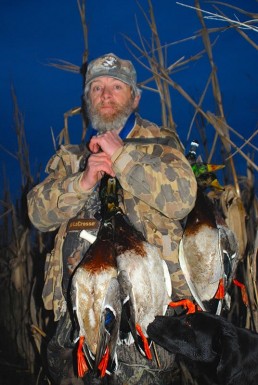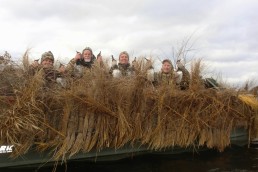Dare to be Different to Pull in More Ducks
SHARE THIS POST
Every aspect of our society has become so pigeonholed that we all have become victims of the cookie-cutter syndrome—if we see it on TV or online, we copy it. It is called mass merchandising, and it works on the masses, relieving us of our hard-earned money and sometimes our personal identities and our decision-making abilities. As waterfowl hunters, we may look sharp enough with our latest camo pattern, best waders, super shotguns and realistic looking decoys, but our conformity, unfortunately, can cause us to miss the mark when it comes to harvesting ducks.
Some say looking sharp helps us act sharp. I do not disagree, however, when we look like every other hunter up the flyway and our decoy spreads only duplicate what migrating ducks have already seen a thousand times, the wily birds often avoid us.
Mallards are popular among waterfowl hunters, and it shows. Many hunters go with solid mallard decoy spreads, as they do look sharp, but so much so that a catalog designer could have laid out the real imagery dekes.
Mix things up
If you want to kill more ducks, begin by changing up your decoy spread and add variety. Toss a handful of pintail decoys to one side. The brilliant white of the pintail decoys will be seen by ducks long before a standard mallard decoy.
In the wild, ducks often fly in mixed-species groups. Mix yours up as well and put in a few decoys representing other species. Shoveler males are brightly colored and will help fool wary migrators. I know they don’t fit the high-class bill of mallards, but they are a drawing card. If you are ashamed of them, keep them in a separate bag, where they can’t be seen. If your buddies poke fun, simply ask them if they would like to kill more ducks. Most will drop the ribbings after the first hunt.
Any species of duck decoy will help improve the attractiveness of a spread. However, it is important to remember the peculiarities of each species. I sometimes toss a dozen bluebill dekes 15 yards to one side of my main sets. I place the bluebill fakes very close together, or on a line. They often bunch up or swim in single file. Teal also cluster tightly, and I like to place the decoys for this duck very near the bank, especially in a sunny location.
Are you enjoying this post?
You can be among the first to get the latest info on where to go, what to use and how to use it!
Dekes are fakes and duck hunters think they have to imitate live ducks to perfection. That is simply not the case. When I first started duck hunting, because of budget restraints, I utilized empty, white bleach bottles. I took a black magic marker and painted a black wing patch on each bottle. They worked like a charm and I used them for years. I eventually bought real decoys, simply because they look better for photos for magazines.
If you really get into the idea of multi-species decoy sets and have weathered the storm of teasers tossed at you by your hunting buddies, go the ultimate route and pack 25 to 30 coot decoys along. Coots are great confidence decoys and travel en masse and feed voraciously. Attach jerk strings to several of the coot decoys to bring them to life. Many duck species simply cannot resist settling in near a bunch of coots, and wigeon are especially vulnerable. Coots may be considered confidence decoys because the live versions feel safe when surrounded by a bunch of coots.
Make a fine blind
Boat blinds are another facet of duck hunting that’s often misunderstood. Up and down the flyways, duck hunters utilize large, box-shaped blinds on their boats. From the air, the human eye easily detects them. Ducks have eyesight eight times better than that of humans. It stands to reason that ducks quickly become accustomed to seeing the box-shaped structures, which spit fire and death. Of course, they are going to flare away from the most easily recognized boat blinds.
I break my boat up with sheets of camo material laid right over the top of the boat. I do not use a blind frame, thus avoiding the boxy-looking effect. The camo follows the uneven contours of my boat, helping to create an illusion that “blinds” easily into the bank-side cover. I sit in my boat seat and enjoy easy shooting as ducks approach my decoy set.
As one last tip, don’t hide the coot decoys from public view. The cookie-cutter duck hunters will give you a wide berth. And that really cuts down on the competition.
Did you enjoy this post?
You can be among the first to get the latest info on where to go, what to use and how to use it!
Bill Cooper
An inductee to the National Fresh Water Fishing Hall of Fame, Bill Cooper, from the Missouri Ozarks, has written over 4,000 articles on outdoor subjects. You can hear him on Wild at Heart Outdoor radio at espn1073.com.



